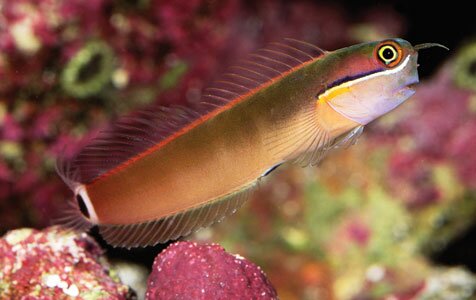Blenniidae
From Microcosm Aquarium Explorer

Ecsenius stigmatura, Tailspot Blenny. Scott W. Michael
Overview
The blennies are a diverse group of elongate, laterally compressed fishes, with no scales, a blunt head, pelvic fins that are positioned in front of the pectoral fin base (members of the genus Plagiotremus lack pelvic fins), comblike teeth, a long, continuous dorsal fin that has fewer spines than soft rays (in the majority of species).
The adults of most species lack a swim bladder (the members of the genera Aspidontus, Meiacanthus, Petroscirtes, and Plagiotremus have a very small swim bladder). Almost all the blennies inhabit marine habitats, although at least one (Meiacanthus anema) enters freshwater. Others may occur in brackish estuaries.
BioGroup:
Native range:
Taxonomic rank: Family
Common name: Blennies or Combtooth Blennies
| Total known | Total profiles | |
|---|---|---|
| Subfamilies | 0 | 0 |
| Genera | 56 | 13 |
| Species | 360 | 4 |
Captive care: A relatively small number of blennies are available to aquarists. For example, only two species in the genus Ecsenius, which is comprised of 46 small species—most of them attractively marked—are regularly seen in the aquarium trade. Many do well in captivity, especially if the tank contains a healthy growth of microalgae. Provide a small to large aquarium aquascaped with an ample quantity of rock for hiding and grazing.
Feeding: Most of the blennies scrape diatoms and filamentous algae off hard substrates. Some blennies have venomous fangs and will bite the inside of a piscivore’s mouth if they are ingested. Harmless blennies, cardinalfishes, and sea breams mimic some of these venomous species. There are also predatory blennies that prey on small invertebrates, while others meet their nutritional needs by biting scales and slime from the bodies of unsuspecting fishes.
Some of the blennies feed on the scales of larger fishes, while others have poison fangs they can use if attacked by a piscivore. Some blennies eat live stony corals, while others will nip tridacnid clam mantles.
Feed a varied diet that includes regular offerings of plant material. (Some species require an established system with a rich growth of microalgae to thrive.)
Notes: Except when keeping a mated pair, a single specimen of a particular species per aquarium is the rule. However, it is possible to keep blennies of different species in the same aquarium, although closely related forms may fight.
Subfamilies
none
Genera
- Aspidontus
- Atrosalarias
- Blenniella
- Cirripectes
- Ecsenius
- Exallias
- Istiblennius
- Meiacanthus
- Ophioblennius
- Parablennius
- Petroscirtes
- Plagiotremus
- Salarias








